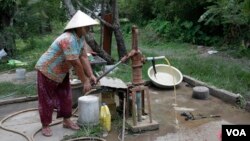About 20 years ago, villagers in Samrong commune in Svay Rieng province’s Chantrea district near the border with Vietnam had to travel from village to village before dawn to transport water to the area.
But in recent years the situation has improved after villagers took it upon themselves to dig reservoirs and wells near their homes.
The makeshift reservoir has become the villagers’ main source of water as the dry land does not lend itself to wells. To dig a working well, they would need to spend from $1,000 to $2,000.
Nhim Ly, 38, a Chek village resident, owns a 600-square-meter reservoir behind his house, which provides all the water his family needs. A food vendor, Ly said he could not afford the cost of digging a professional well.
“I don’t have money, that’s why I dug the lake as a temporary fix,” he said.
Like many of the villagers, Ly is concerned about the health impacts of using the stagnant water. “It’s not hygienic. It can cause diarrhea, but we don’t know what to do since we don’t have money to dig a well,” he said.
Ly’s house abuts the dusty main road that snakes its way through the village, constantly busy with large trucks carrying construction materials back and forth.
Another villager, Oum Khemra, 27, said potentially dangerous minerals had leaked into his water supply. “I can’t cook using this water, it’s only good for washing clothes,” he said.
“It affects our health, but I don’t know what to do. There is no clean water. But if we filter it, it is better. It’s difficult but we are used to it since we’ve used it since we were young.”
Sok Saro, Samrong commune chief, said access to clean water is the issue of most concern to villagers.
“Our area lacks water and when there is a drought, it is very difficult. There’s no river water here,” he said.
Hand dug wells are widely used throughout Cambodia, but increasingly drilled wells and hand pumps are becoming more available.
According to the Ministry of Rural Development, more than 630,000 wells have been drilled across the country, with more than half of Cambodia’s rural population now having access to clean water.
The government has committed to bringing clean water to all households by 2025.
Chan Darong, a rural development spokesman, says the government is paying particular attention to Chantrea district, which is one of the more difficult areas to provide for.
“In Chantrea district, some areas have lakes, but some don’t. So the ministry has plans to dig very deep wells. We also have plans to dig more lakes for people, too,” he said.
He added that education about safely using water was also a top priority.
However, the extra cost of tapping water directly into villagers’ homes was prohibitive, he said.
Bunly Meas, a Unicef spokesman, said the lack of access to clean water was a major challenge affecting particularly infants and their caregivers, while almost 40 percent of Cambodia’s rural population does not have access to clean drinking water.
“Without safe water and adequate sanitation and hygiene, children ... are especially vulnerable to water-borne diseases,” he said.








